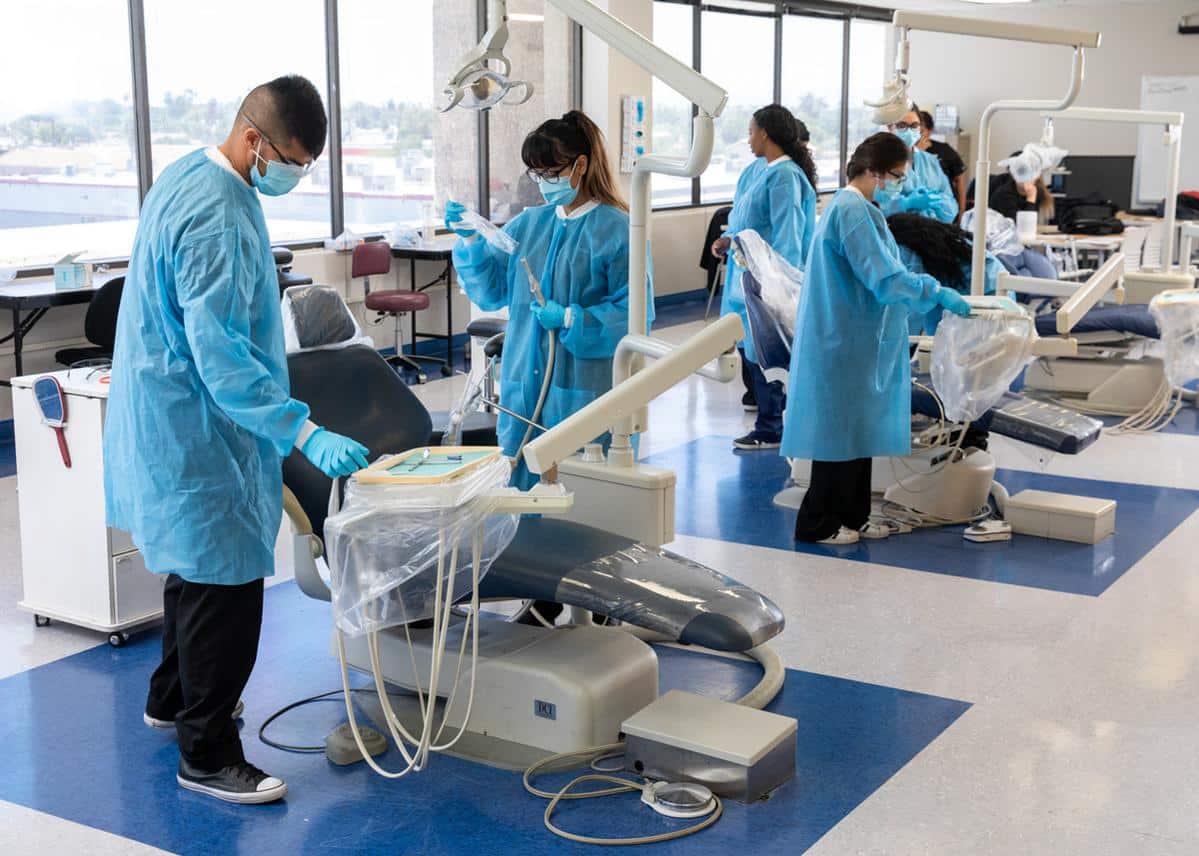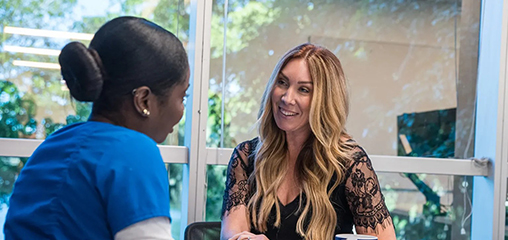
When you walk into a dentistry office, you interact with people in varying roles that all work together to ensure that you receive optimal dental care. Dentists rely on support staff, usually dental assistants and dental hygienists, to help them deliver high quality care to their patients. Many people are confused about the differences between dental assistants vs. dental hygienists.
While both dental assisting and dental hygiene are rewarding healthcare careers with a positive job outlook, there are some key differences between their roles.
In this post, we’ll explore the differences between a dental assistant vs. dental hygienist career, their key responsibilities, the pathways to pursue each position, and which role might be a fit for you based on your own career goals.
Dental Assistant – Job Overview
 Dental assistants work in dental offices to ensure that the office is functioning effectively. The dental assistant is who the dentist relies on to keep the schedule flowing throughout the day and assist with patient care. They’ll most often work in clinical roles and administrative roles as needed at various points. While working clinically, they function under the direct and indirect supervision of a dentist or hygienist during patient care and exams. On the administrative side, they’ll work to support office responsibilites including patient paperwork. Dental assistants typically work in general dental offices, but they can also specialize in fields like orthodontics, oral surgery, cosmetics, or pediatric dentistry.
Dental assistants work in dental offices to ensure that the office is functioning effectively. The dental assistant is who the dentist relies on to keep the schedule flowing throughout the day and assist with patient care. They’ll most often work in clinical roles and administrative roles as needed at various points. While working clinically, they function under the direct and indirect supervision of a dentist or hygienist during patient care and exams. On the administrative side, they’ll work to support office responsibilites including patient paperwork. Dental assistants typically work in general dental offices, but they can also specialize in fields like orthodontics, oral surgery, cosmetics, or pediatric dentistry.
Role of a Dental Assistant
Dental assistants work in both patient care and assisting with office tasks. Each day as a dental assistant is different and you’ll work in a wide variety of areas of the dental practice. This can be great for someone just beginning their healthcare career as they’re able to acquire a lot of valuable skills.
Patient Care Functions Might Include:
- Obtaining dental history from patients
- Obtaining base vital signs from patients
- Setting up for procedures and exams
- Sterilizing instruments and cleaning procedure areas and equipment
- Passing instruments to the dentist before, during, and after procedures
- Mixing dental materials before, during, and after procedures
- Making and cementing temporary crowns and bridges
- Taking and developing digital and film x-rays
Office Functions Might Include:
- Customer service (answering phones, setting up appointments, processing payments, etc.)
- Processing insurance claims for patients
- Obtaining dental records
- Inventory counts and ordering supplies
A Day in the Life of a Dental Assistant
Overview:
The dental assistant will often start their day by turning on all dental equipment, and filling tools like the ultrasonic cleaner and sterilizer. The dental assistant will also review the schedule and make sure all instruments, materials and equipment are available for the day’s procedures.
As patients arrive, the dental assistant will bring them to the dental treatment room or procedure area and review their medical history. The dental assistant helps the dentist with all procedures. This will include mixing and handing instruments and materials to the dentist as they need them or obtaining diagnostic x-rays for the dentist to review.
After the procedure, the dental assistant will provide patient education, schedule a follow-up appointment, and process insurance information for each patient only if needed. Breakdown the procedure area, handle trays and instruments, reset procedure area for the next patient.
Throughout the day, the dental assistant will continue to prepare for appointments and aid the dentist with exams and procedures. Every day in this role is different, so the dental assistant could do tasks as varied as ordering specialized dental materials to calming a nervous patient.
Setting Up for the Next Day
The dental assistant will also review the appointments scheduled for the next day. The DA may contact patients to confirm their appointment and to answer any questions they might have. Before leaving that day, the dental assistant will clean and set the procedure areas for the next morning. This can include a variety of tasks like running the dental lines, setting up procedure trays, and sterilizing the instruments.
Dental Hygienist – Job Overview
 Dental hygienists offer preventative dental care to clients. While the dentist still provides oversight and examination, hygienists work to deliver cleanings and initial assessments one-on-one with their patient. Dental hygienists use various tools to remove plaque, assess oral health, and provide treatments. They typically work in dental offices but can also work in alternative settings, such as research organizations or schools, depending on their training.
Dental hygienists offer preventative dental care to clients. While the dentist still provides oversight and examination, hygienists work to deliver cleanings and initial assessments one-on-one with their patient. Dental hygienists use various tools to remove plaque, assess oral health, and provide treatments. They typically work in dental offices but can also work in alternative settings, such as research organizations or schools, depending on their training.
Role of a Dental Hygienist
Dental hygienists typically follow a scheduled list of client appointments throughout their day. They see patients for cleanings, perform assessments, and provide hygiene education. Their day-to-day tends to be more routine as they follow similar patterns with each patient they see.
Functions might include:
- Removing plaque from teeth
- Applying fluoride or sealant treatments
- Take and develop x-rays
- Assess dental health
- Work with dentist to develop treatment plan
- Educate patients on oral health
A Day in the Life of a Dental Hygienist
A dental hygienist will start by reviewing the schedule for the day and preparing the room for seeing patients. This includes stocking the room with your dental tools, filling the water containers, and laying out the tray for the first appointment.
As each patient arrives at the office for visits, the dental hygienist escorts them back to the treatment room. For most patients, hygienists remove tartar and plaque, assess oral health, and take x-rays. Then, they work with the dentist to come up with a treatment plan for the patient. Hygienists provide individualized patient education about hygiene and oral health. After treatment, a dental hygienist schedules follow-up appointments and provides take-home materials.
After lunch, the hygienist continues to see patients as scheduled throughout the afternoon. Before leaving for the day, they ensure all patient progress notes are properly documented. Lastly, instruments should be added to the sterilizer machine and water lines are emptied. This will ensures equipment is ready for tomorrow morning.
Key Differences Between Dental Assistants and Dental Hygienists
While both roles work in the dentistry setting, there are many key differences between dental assistants vs. dental hygienists. These differences include education needed, licensing requirements, job duties, earning potential and career advancement opportunities available for dental assistants vs. dental hygienists.
Education and Training
While some form of education is typically needed to pursue both dental assisting and dental hygiene, the path to becoming a dental assistant is much quicker than a dental hygienist.
| Dental Assistant Education | Dental Hygienists Education |
| Diploma or certification program in dental assisting These programs typically take 6 months to 1 year to complete | Complete an associate’s degree program These programs typically take two years to complete
Some dental hygienists go on to complete a bachelor’s degree or other advanced degrees |
Certification and Licensing
Requirements for becoming a dental assistant vs. a dental hygienist vary by state. Dental assistants pursue certification while dental hygienists pursue licensing. Becoming a certified dental assistant brings fewer requirements than becoming a licensed dental hygienist.
| Dental Assistants | Dental Hygienists |
| Typically, states do not require licenses to enter the profession Certifications may be required for advancement or specialties | Most states require a degree from an accredited program for licensing Most states require passing both written and clinical examinations for licensing |
Job Duties
While both dental assistants and dental hygienists work with dentists to optimize oral health of their patients, their job functions differ. Dental hygienists tend to focus more on preventative care and they function more independently than dental assistants.
| Dental Assistants | Dental Hygienists |
| Work under direct and indirect supervision of the dentist Function in both administrative and clinical roles
One-on-one work with clients Varying day-to-day work |
Provide cleanings, assess oral health, and provide client education independently of the dentist Typically work one-on-one with their clients.
More routine daily work |
Salary Data
The earning potential of dental assistants vs. dental hygienists varies by location, experience and job type. While dental hygienists do earn more on average, a dental hygienist degree takes longer to complete than a dental assistant program. If you’re aiming to enter the dental field sooner, a dental assistant career could be a better choice.
| Dental Assistants | Dental Hygienists |
| Average Hourly Wage – $21.55 Average Annual Wage– $44,820
Job Growth Potential– Projected job growth is 7% by 2032, with anticipated 55,100 job openings. This is faster than average job growth per the BLS. (Source) |
Average Hourly Wage – $39.14 Average Annual Wage– $81,400
Job Growth Potential– Projected job growth is 7% by 2032, with anticipated 16,400 job openings. This is faster than average job growth per the BLS. (Source)
|
Career Advancement
The career advancement opportunities differ between dental assistants and dental hygienists. While people in both fields can pursue specialties, dental assistants typically pursue career advancement through certifications and dental hygienists advance with increased degrees. It’s worth noting hat dental assistant work experience can help you get accepted into a dental hygienist program t / pursue a dental hygienist career down the road.
| Dental Assistants | Dental Hygienists |
| Opportunities for additional certifications (for instance, Radiation Health and Safety Certificate to process x-rays) Certifications typically make dental assistants more marketable
Ability to specialize in areas such as pediatrics, orthodontics, or oral surgery Work experience as a DA can help you get accepted into dental hygienist school if you apply in the future
|
Specialization through more advanced degrees Opportunities available in leadership, education, and research |
Which role is right for you?
Getting Started
When do you see yourself starting work? If you are looking to start your career as soon as possible, you might consider dental assisting. Most dental assistant programs can be completed in a year or less. At Arizona College for example, you can complete our dental assistant program in about 9 months. Dental hygienist programs typically take about two years to complete and require examinations to obtain a license. You must be licensed as a dental hygienist before you can begin work.
Work Traits for Dental Assistants vs. Dental Hygienists
What kind of role would fit your work style? Both dental assistants and dental hygienists must have a passion for dental hygiene. They are excellent communicators that must work collaboratively with patients and dentists. However, there are some qualities that may be better suited in each of these roles, as detailed in the table below:
| Dental Assistants | Dental Hygienists |
| Teamwork Must collaborate with the dentist during procedures and exams by anticipating and adapting to their needs
Working with other office staff to ensure supplies are available when needed |
Attention to Detail Close attention to detail in assessing oral health ensures that nothing is missed
Providing dental hygiene requires attention to the details of each segment of the oral cavity |
| Organization Managing scheduling appointments and insurance
Set-up and cleaning of dental instruments |
Critical Thinking Assessment of patients’ unique oral cavities
Assisting dentists with developing treatment plans that are appropriate for each patient |
| Multitasking Manage many different responsibilities like assisting with procedures, ensuring adequate supplies for the office, and following up for patient appointments
|
Time Management Manage time-slotted appointments throughout the day
Balance the time spent with each patient to ensure thorough care |
| Infection Prevention Required to handle and sterilize dental instruments
Cleaning equipment after use Office cleanliness |
Educator Must be able to effectively evaluate the learning needs of each patient
Provide patient education in a way the learner understands |
Job Growth Potential
With the increased understanding of the connection between oral health and general health, there are many efforts to expand preventative dental services. The U.S. Bureau of Labor Statistics predicts steady job growth for both dental assistants and dental hygienists over the next ten years, suggesting promising opportunities for those that pursue either job.
As dentists are in higher demand and efficiency of their practice is prioritized, the BLS predicts that the demand for dental assistants will also rise. They predict there will be about substantially more new job opportunities for dental assistants vs. dental hygienists by 2032 (source). Projections show approximately 25,700 new job openings for dental assistants between 2022 – 2032 vs. 16,300 openings for hygienists (source). If you’re looking for a rewarding healthcare career with more job opportunities, dental assisting might be a better fit.
How Arizona College Can Help You Prepare for a Dental Assistant Career
 Are you considering a career as a dental assistant? If so, the team at Arizona College is ready to prepare you for that future. Our dental assistant program can be completed in less than 10 months and we have 2 campuses in the Phoenix Metro area (Mesa and Glendale, Arizona). Our team is ready to help you pursue your new career as a dental professional.
Are you considering a career as a dental assistant? If so, the team at Arizona College is ready to prepare you for that future. Our dental assistant program can be completed in less than 10 months and we have 2 campuses in the Phoenix Metro area (Mesa and Glendale, Arizona). Our team is ready to help you pursue your new career as a dental professional.
Why Choose Our Dental Assistant Program?
- Online/In-Person hybrid class format
- Receive an iPad as part of enrolling
- Gain experience in real-world dental offices
- Campuses in both Mesa and Glendale, AZ
- No GED or High School Diploma? We have solutions to help you enroll
- Financial Aid available to those who qualify
Graduates of the Arizona College Dental Assistant program will be eligible to become a certified dental assistant through the Dental Assisting National Board (DANB).
References:
Bureau of Labor Statistics, U.S. Department of Labor, Occupational Outlook Handbook, Dental Assistants, at https://www.bls.gov/ooh/healthcare/dental-assistants.htm (visited February 6, 2024).
Bureau of Labor Statistics, U.S. Department of Labor, Occupational Outlook Handbook, Dental Hygienists, at https://www.bls.gov/ooh/healthcare/dental-hygienists.htm (visited February 6, 2024).
Author Bio:

Emily Mallory is a master’s prepared Registered Nurse and writer based in New England. Her writing is fueled by her experience in both nursing education and bedside nursing in the Emergency Department, Intensive Care Unit, and Pediatrics.
Start Your Future in Nursing Today

If you’re considering a career as a registered nurse (RN), Arizona College of Nursing is here to help you pursue your dream. Our BSN program enables you to earn a Bachelor of Science in Nursing in just 3 years or less with qualifying transfer credits. We’ve helped hundreds of students to earn a BSN degree and enter the nursing profession – and we’re ready to support you on your path to becoming an RN.
Why Choose Arizona College of Nursing?
- Earn a BSN degree in 3 years or less with eligible transfer credits
- Campus locations throughout the US
- Night classes for general education courses
- Hybrid Online/In-Person format for general education classes
- Nursing education is all we do
- CCNE-Accredited Program*
- NCLEX-RN success coaches and exam preparation class
- Financial aid available to those who qualify
Discover Your Path to a Career in Nursing
Information in this post is accurate as of March 6, 2024.
*The Bachelor of Science in Nursing (BSN) degree program at Arizona College of Nursing is accredited by the Commission on Collegiate Nursing Education (https://www.aacnnursing.org/). All Arizona College of Nursing and Arizona College campuses are institutionally accredited by the Accrediting Bureau of Health Education Schools (https://www.abhes.org/), a U.S. Department of Education-recognized accrediting agency.








